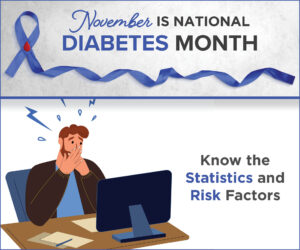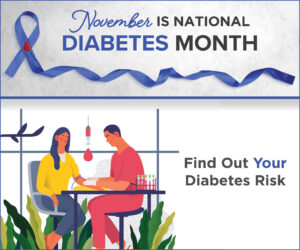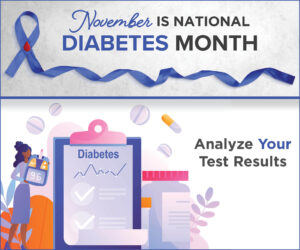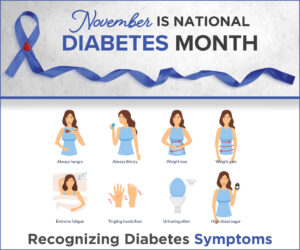November is National Diabetes Month, a time when communities across the country seek to bring attention to diabetes. It’s important to know the statistics, prevention methods, testing options, and to be able to recognize the possible symptoms of this disease, especially if you are more susceptible to developing diabetes due to age, lifestyle choices, overall health, family history, or other contributing factors.
 Statistics and Risk Factors
Statistics and Risk Factors
The numbers are staggering. In general, diabetes affects over 37 million Americans, with 1.4 million new cases diagnosed in the United States each year. And that doesn’t even account for the undiagnosed cases, or the roughly 96 million American adults living with prediabetes.
Family history, certain health conditions, and age can all play a role in the development of diabetes. A poor diet and excess weight can also be contributing factors.
Diabetes can cause serious medical problems for the eyes, ears, kidneys, nerves and feet. For example, hearing loss is twice as common for seniors with diabetes. There’s also an increased risk for high blood pressure, heart disease and stroke.
With diabetes, your body does not make enough insulin or does not use it well. Insulin “unlocks” your cells so they can absorb glucose, a sugar that provides your body with the energy it needs. In people with diabetes, too much glucose stays in the blood.
 Testing
Testing
The most common way to diagnose diabetes or prediabetes is the Fasting Plasma Glucose Test. It’s a simple blood test performed by your physician. After not eating for eight hours (usually overnight), blood is drawn and sent to a lab for analysis. Test results below 100 are considered normal. Results between and 100 and 125 can indicate you have prediabetes, a wake-up call to take action and lower your risk for diabetes. For example, losing as little as 5 percent of your total body weight (7.5 pounds if you weigh 150) can decrease your risk for diabetes.
 Your Test Results
Your Test Results
Levels of 126 or higher typically lead to a diagnosis of diabetes. Levels below this number could still indicate prediabetes. In addition to suggesting you eat a healthier diet and exercise more, your doctor will work with you to get your diabetes under control. You may have to start checking your blood sugar several times a day and begin having insulin injections.
 Diabetes Symptoms to Watch
Diabetes Symptoms to Watch
You should see your physician if you experience any of the following symptoms:
• Increased thirst and more frequent urination
• Increased hunger
• Weight loss
• Feeling fatigued
• Blurred vision
• Slow healing sores or frequent infections
• Areas of darkened skin
Diabetes isn’t just a disease. It’s an epidemic. Know your risks, what symptoms to watch out for, and how to handle a diabetes or prediabetes diagnosis. Talk to your primary care physician for more information, or visit https://diabetes.org/.
Source: American Diabetes Association
